Maximizing Engagement: The Power of Follow-up Emails
Should You Email After No Response?
Understanding the Value of Persistence
When you send an email after no response, you might wonder whether it’s appropriate to send another. The decision to write a follow-up is strategic, balancing persistence with respect for the recipient's time and inbox. Here, we'll explore why and how you should approach this situation.
Balancing Persistence with Professionalism
While follow-ups are crucial, knowing when to stop is important. Too many follow-up emails can be perceived as intrusive or pushy, which could be counterproductive.
Respecting Boundaries: If you've sent a couple of follow-up emails without a response, it might be time to pause and reassess your strategy. Consider reaching out through different channels or at a later time.
Reading the Silence
Sometimes, no response might be a response in itself. It’s crucial to read between the lines and understand when silence might be indicative of disinterest or a lack of relevance. Use this as feedback to refine your approach in future communications.
Reflect and Adapt: Use the experience to learn about effective email strategies, subject lines, and content that resonates with your audience.
Data-Driven Insights: Enhancing Reply Rates with Email Follow-Up Strategies
Picture this: your initial email garners a 9% response rate. But, with a strategically timed follow-up email, this rate can leap to 13%.
For seasoned email communicators, a single follow-up can rocket a 16% reply rate to an impressive 27%.
These statistics are not mere numbers; they underscore the transformative power of follow-up emails in your email sequence, particularly when it comes to business and professional exchanges.
Six Crucial Reasons to Utilize Follow-Up Emails Effectively
Each follow-up email you send plays a distinct role in your overall communication strategy, addressing various challenges and maximizing opportunities.
From ensuring your message is seen to refining your approach based on recipient feedback, follow-up emails are a multifaceted tool.
Let's explore the key reasons why they're so effective:
- Bypassing Inbox Clutter: Your follow-up email cuts through the noise, ensuring your message gets noticed.
- Evading Spam Filters: A well-crafted follow-up is less likely to end up unseen.
- Stimulating Responses: The second or third email often prompts a reply when the first doesn't.
- Rectifying Email Mishaps: Follow-ups provide an opportunity to fix issues from your initial email.
- Timing Perfection: Sending a follow-up could coincide with better timing for your recipient.
- Message Refinement: Tailoring your follow-up to your recipient’s needs and preferences is key.
Five Problems Solved by Strategic Follow-Up Emails
Effective follow-up emails are not just about persistence; they're about strategy.
They tackle specific problems and turn potential obstacles into opportunities for engagement and connection.
From enhancing visibility to ensuring your message resonates with the recipient, strategic follow-ups can revolutionize your email communication. Let's delve into the problems they help solve:
- Closing More Deals: Regular, thoughtful follow-ups keep your proposal at the forefront, enhancing deal closure rates.
- Boosting Response Rates: A timely follow-up can be the nudge your prospect needs to respond.
- Securing Top Inbox Position: Thoughtful follow-ups can keep your emails visible and prioritized.
- Reengaging Prospects: In our fast-paced digital world, follow-ups can effectively recapture the attention of your prospects.
- Ensuring Email Visibility: Follow-ups increase the likelihood that your message is seen and acknowledged.
Incorporating a range of follow-up strategies is vital. Adapting your approach is crucial, whether it's a polite follow-up email after a networking event or a more direct message in a sales context.
Remember, the goal is to enhance the quality and relevance of your communication, not just the frequency.
By doing so, you’re not just sending follow-up emails but fostering stronger connections and driving more meaningful engagement.
Step-by-Step Guide - How to Write Follow-Up Emails
Step 1: Starting with a Personalized Greeting
Crafting an effective follow-up email begins with a personalized touch. A greeting tailored to the recipient lays the foundation for a meaningful connection.
It's not just a formality; it's about making the recipient feel recognized and valued.
This is your first step in transforming a standard follow-up into an impactful communication.
Personal Touch: Address the recipient by their name for a direct and personal connection.
Step 2: Referring to the Initial Email or Previous Interaction
Briefly recap to reconnect the dots from your previous communications is crucial. Referencing your initial email or last interaction provides context and continuity.
It's more than a gentle reminder—it’s about building a cohesive narrative that flows from your past conversations to your current message.
Contextual Link: Mention specific details from your initial email or last meeting to create a sense of ongoing dialogue.
Step 3: Restating Your Purpose with Clarity
Clarity is the cornerstone of effective communication.
In this step, reiterate the purpose of your email with precision. Provide context, and clarify your intention to avoid ambiguity, Whether you're following up on a previous request or nudging for a delayed response.
Clear Intent: Explicitly state your email's purpose to ensure the recipient understands your objective.
Step 4: Providing Immediate Value and Key Details
Your follow-up email should be a friendly reminder and a value addition. Offer key details or insights that enhance the recipient's understanding or provide them with useful information.
This step ensures your email adds value to the right person and their day. Ensure you are trying to solve a pain point and not many.
Value Addition: Include pertinent information or a summary of crucial points to make your email informative and helpful, including the desired outcome.
Step 5: Suggesting Next Steps - The Art of a Strong Call to Action
A compelling call to action (CTA) is pivotal in guiding your recipient towards the next step. Whether it’s scheduling a next meeting request, providing a response, or making a decision, your CTA should be straightforward and actionable - this could be getting on a quick chat or response to your job application or whatever the resolution you are looking at.
Actionable CTA: Craft a clear and concise call to action that guides the recipient on the expected next steps.
Step 6: Ending Your Email with Kind Regards
A courteous conclusion to your email can leave a lasting impression.
Ending with a phrase like 'Kind regards' combines professionalism with a personal touch, leaving the recipient with a positive view of the interaction.
Warm Closure: Use a polite and friendly sign-off to conclude your email on a positive note.
Step 7: Proofreading for a Professional Finish
The final step is thorough proofreading. Ensuring your email is free from errors and well-composed reflects your professionalism and respect for the recipient’s time.
Attention to Detail: Review your email for any grammatical errors or typos to maintain a professional standard. Ensure the links provided work.
Step 8: Use PostScript Wisely
The Post Script (P.S.) in an email is a powerful tool often overlooked in follow-up emails. This section can provide additional value, subtly helping to generate business.
Think of the P.S. as a strategic spot to drop a compelling nugget of information, an enticing offer, or a personal note that might have felt out of place in the body of your email.
Highlighting a Special Offer or Reminder: If there's a limited-time offer or an upcoming deadline related to your business proposition, mention it in the P.S. This can act as a gentle nudge, encouraging the recipient to take action.
Sharing Success Stories or Testimonials: Including a brief testimonial or success story in the P.S. can boost your credibility. It's a way to show, rather than tell, the potential success the recipient can expect by engaging with your business.
Adding Personal Touches: Sometimes, a personal note or a light-hearted comment can make your email stand out. If you've built a rapport with the recipient, a friendly, personal remark in the P.S. can reinforce that connection.
Offering Additional Resources: Links to helpful resources, be it a blog post, case study, or instructional video, can add value to your email. It shows that you're interested in a transaction and in providing genuine value.
Timing and Strategy for Follow-Up Emails
How Long Should I Wait Before Sending a Follow-Up
When it comes to follow-up emails, timing can be as critical as the content itself. Striking the right balance between being proactive and giving your recipient enough time to respond to your initial email is essential.
Waiting about a week is generally advisable, as it shows that you respect their time while keeping your correspondence relevant. Subsequently, wait for a week after the first follow-up email.
Respecting the Waiting Period: A one-week interval is considerate, acknowledging both the busy schedules of email recipients and the importance of your request.
How Many Times Should I Contact
Deciding on the number of follow-ups is a blend of art and science. While there's no one-size-fits-all answer, the consensus among email communication experts leans towards two to three follow-up emails. This approach is often enough to remind the recipient of your previous email without overwhelming them.
Frequency vs. Purpose: Ensure each follow-up adds value or new information rather than just repeating the same request.
Understanding the Right Balance in Frequency
The frequency of your follow-up emails should reflect a deep understanding of the recipient's needs and your relationship with them. Each industry, and indeed each recipient, might have different expectations.
It's about finding that sweet spot where your emails are frequent enough to keep you and your company name on their radar but not so frequent that they become a nuisance.
Customizing Your Approach: Tailor your follow-up frequency to the specific context of your relationship and the nature of your request.
Why Use the Original Subject Line in a Follow-Up Email
Using the original subject line in a follow-up email is more than just a matter of convenience; it's a strategic choice that can significantly impact your email's effectiveness.
Here are five reasons why sticking to the original subject line can be beneficial:
Continuity and Recognition: The original subject line maintains a thread of continuity. It helps your recipient quickly connect your follow-up with previous communications. This recognition is crucial in an inbox full of new emails and can be the difference between your follow-up email being opened or overlooked.
Building on Previous Engagement: If your initial email got the reader interested, using the same subject line in your follow-up can capitalize on this existing engagement. It reminds the email recipient of their initial interest and encourages them to revisit the conversation.
Efficiency in Communication: Consistency in subject lines streamlines communication, making it easier for both you and your recipient to track the email thread. This efficiency is especially important in professional settings where time is valuable and clear, concise communication is appreciated.
Avoiding the Spam Trap: Frequently changing subject lines can sometimes trigger spam filters, especially when sending to new contacts. Sticking with the original subject line minimizes this risk, ensuring your email reaches the intended inbox.
Facilitates Easier Search and Reference: Using the same subject line makes it easier for recipients to search for and refer back to your emails. This is particularly helpful in longer email threads or when dealing with complex subjects that require referencing previous emails for context.
How to Write a Strong Subject Line for Impact
A compelling subject line is your first chance to capture the recipient's attention. It should be clear, concise, and engaging, possibly hinting at the value or urgency of the email's content. Personalizing the subject line, when appropriate, can increase the likelihood of your email being opened.
Here are five key strategies to create subject lines that prompt your recipients to open and engage with your emails:
Personalization: Tailor your subject line to the recipient. Including their name, referencing a recent event, or mentioning a specific detail from a previous interaction can make your email stand out.
Personalized subject lines demonstrate that you're not sending generic content, which increases the likelihood of a response.
Clarity and Relevance: Be clear about the email's content and why it matters to the recipient. Avoid vague or overly clever lines that might confuse or mislead.
Your subject line should quickly convey the value or importance of your email, making it relevant to the recipient's interests or needs.
Brevity: Keep your subject lines short and sweet. A concise subject line is not only scannable but also more likely to be fully visible in the recipient's inbox, especially on mobile devices. Aim for subject lines that are around 50 characters or less.
Intrigue and Curiosity: Spark curiosity with your subject line. Ask a compelling question, tease interesting data, or hint at valuable insights contained in the email. This approach can pique the recipient's interest and drive them to open the email for more information.
Testing and Refining: Use A/B testing to determine what works best for your audience. Consider using subject line tester tools to refine your approach. Regularly reviewing the performance of different subject lines can help you understand what resonates best with your recipients.
For more insights on crafting effective email subject lines, explore our comprehensive articles on this topic:
- How to Write Subject Lines for Cold Emails
- 7 Best Follow-Up Subject Lines
- Cold Email Subject Lines
- 7 Tips for Crafting the Perfect Cold Email Subject Line
- Email Sales Subject Lines for Sales
- 11 Best Subject Line Tester Tools
- The 2024 Guide for Follow-Up Email: Master the Art
Engaging Potential Clients After Initial Contact
Suppose you are a digital marketing agency specializing in helping small businesses increase their online presence.
You've recently attended a local business networking event where you connected with several potential clients who showed interest in your services.
To follow up, here is a three-part email sequence aimed at engaging these potential clients after the initial contact.
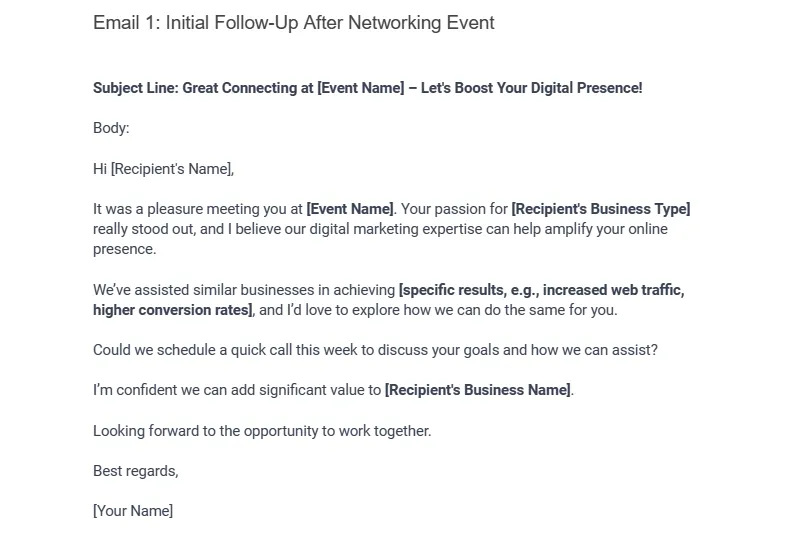

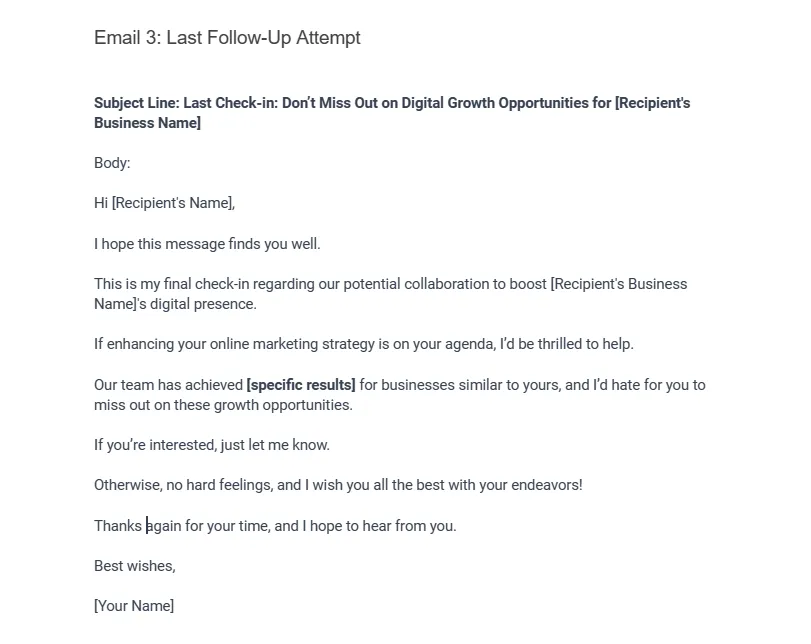
Post-Campaign Engagement and Feedback Collection
Imagine you are a marketing manager who recently concluded a major promotional campaign for a new product.
The campaign involved various stakeholders, including customers, partners, and internal team members.
Now, you want to engage these stakeholders post-campaign to gather feedback and maintain the relationship.
Here's a template you can use.


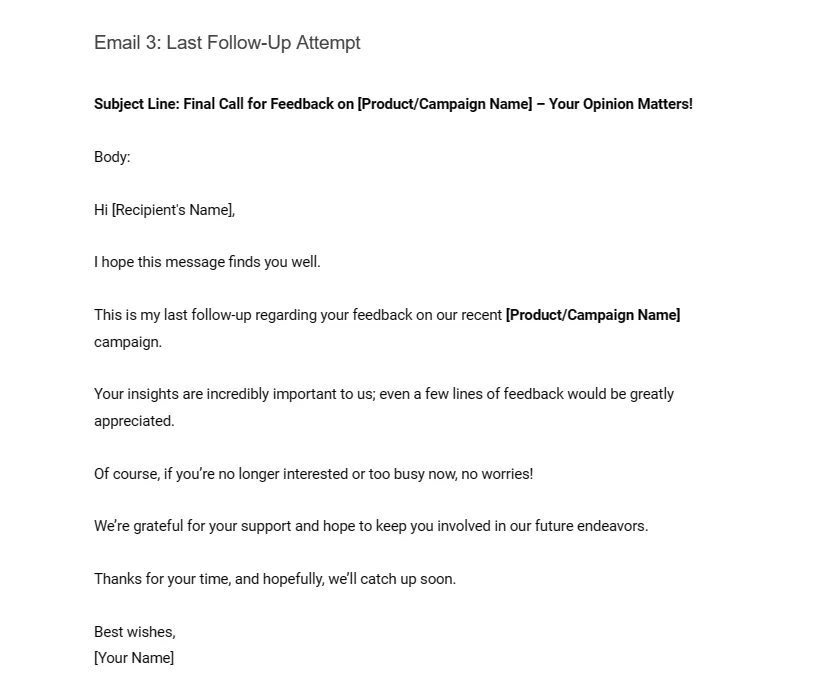
Reaching Out After Submitting a Job Application
Imagine you've recently applied for your dream job at a company you admire. A week has passed since you submitted your application, and you want to proactively reach out to express your continued interest and inquire about the status of your application.
The goal is to demonstrate your enthusiasm and commitment without being overly persistent.
Here is a follow up email template you can use.



Post-Interview Thank You and Inquiry
Imagine you've just had an interview for a position you're excited about.
The interview went well, and now you want to send a follow-up email to thank the interviewers for their time and subtly inquire about the next steps in the hiring process.
This approach shows your appreciation and reinforces your interest in the role.



Building Connections Post-Networking Events
Suppose you've recently attended a networking event where you connected with several industry professionals.
You want to follow up with these new contacts to build on the initial connection and explore potential opportunities for collaboration, advice, or future business relations.
Here's a template you can use.



Following Up on Pending Meeting Requests
Imagine you're a business development manager who has recently sent out several meeting requests to potential clients and partners.
These meetings are crucial for discussing future collaborations and projects. However, you haven’t received responses to some of these requests.
You decide to send follow-up emails to these contacts to remind them of your meeting request and express your continued interest in meeting with them.
Try using the templates below to get them back into the funnel.



Reminders for Outstanding Invoices
Imagine you are a company's finance manager with several outstanding invoices from various clients. These invoices are past their due date, and it's essential to remind the clients about the outstanding payments in a firm way that maintains a positive business relationship.



Engaging Prospects After Sending a Proposal
Imagine you're a sales manager who has recently sent a detailed proposal to a potential client. This proposal is crucial for securing a new contract. It's been a while since you sent the proposal, and you haven't received any feedback yet.
To keep the lines of communication open and gently nudge the client towards a decision, you decide to send a series of follow-up emails.



Following Up on Customer Queries or Complaints
As a customer support manager, you understand the importance of promptly addressing customer queries and complaints.
After initially addressing a customer's concern, you want to follow up to ensure their satisfaction and gather feedback on the resolution.
This helps in maintaining a positive customer relationship and improving your support processes.



Re-engaging Subscribers After a Marketing Email
As a marketing specialist, you understand the importance of maintaining an active and engaged subscriber base.
After sending out a marketing email, it's common to notice some subscribers who haven't interacted recently.
Re-engaging them is crucial for sustaining a healthy email list and maximizing the impact of your campaigns.
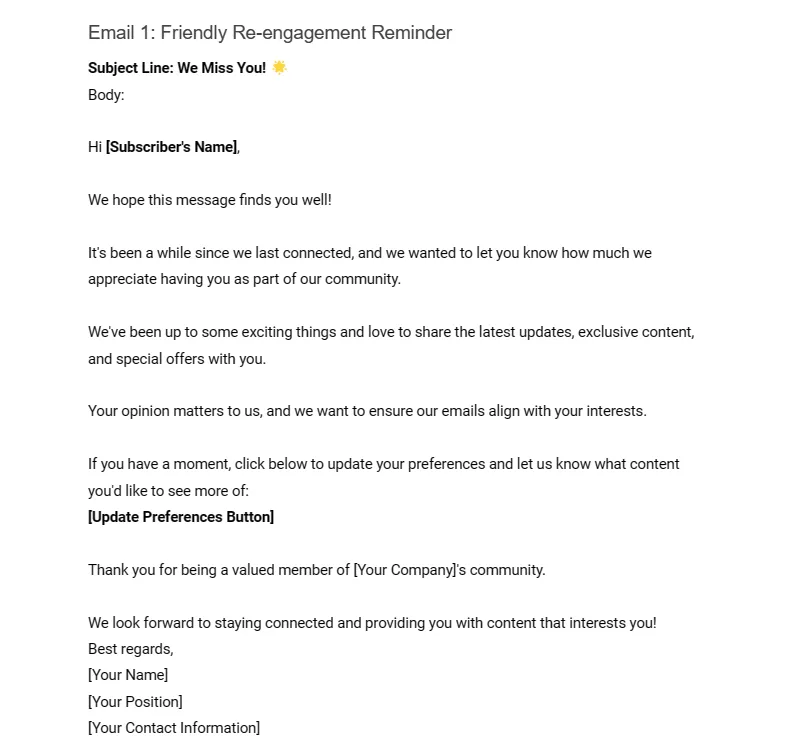
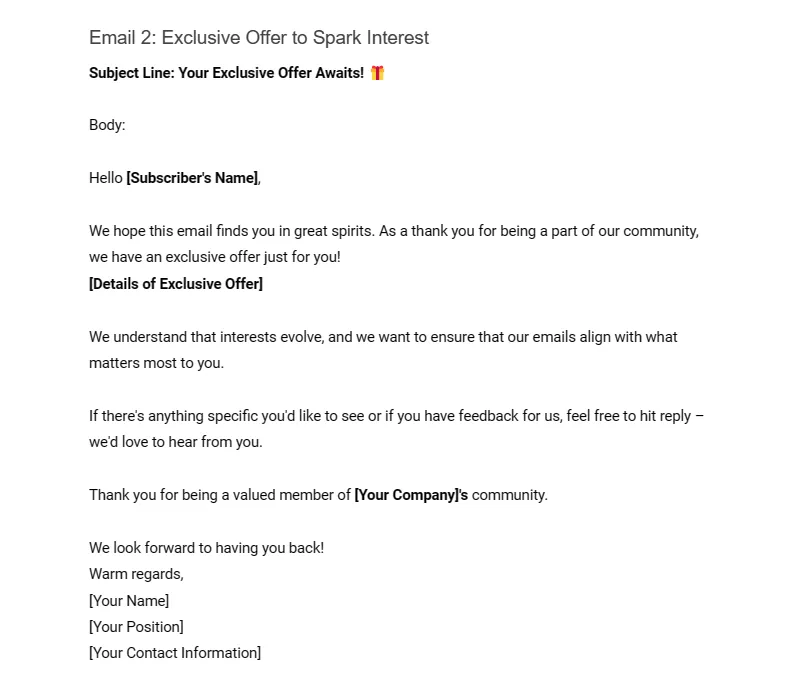
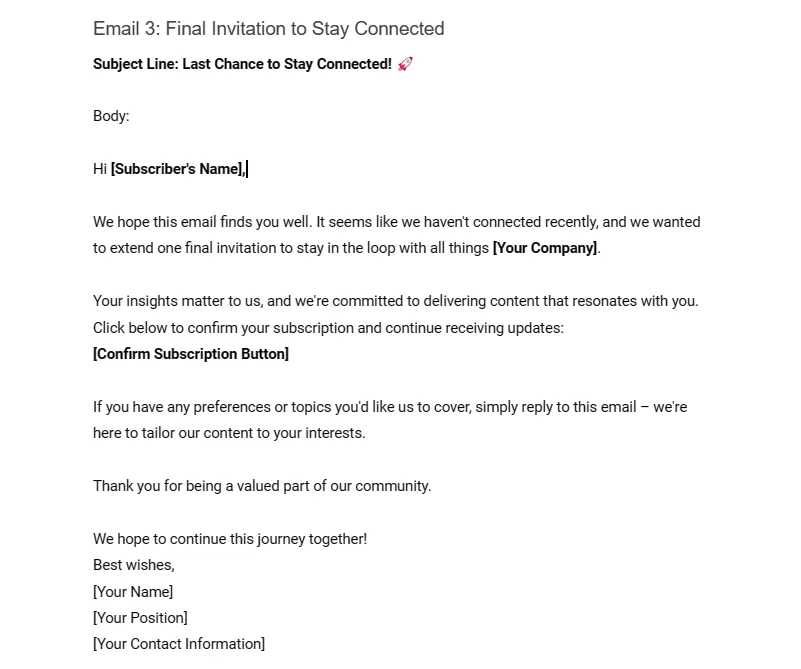
Post-Discovery Call Engagement and Next Steps
After a successful discovery call with a potential client, it's crucial to maintain momentum and guide them toward the next steps in your business relationship.
Crafting thoughtful follow-up emails can solidify the positive impression from the call and provide clear guidance on what comes next.
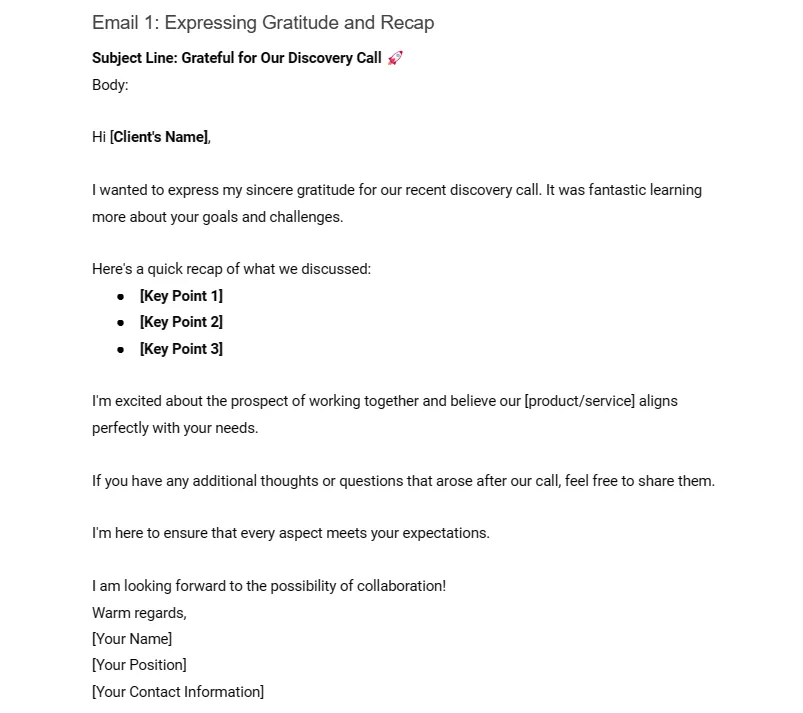


Engaging Attendees After an Event
It's essential to maintain engagement with attendees after hosting a successful event, whether virtual or in-person. Following up promptly not only expresses gratitude but also keeps the excitement alive and opens avenues for future collaboration or participation.
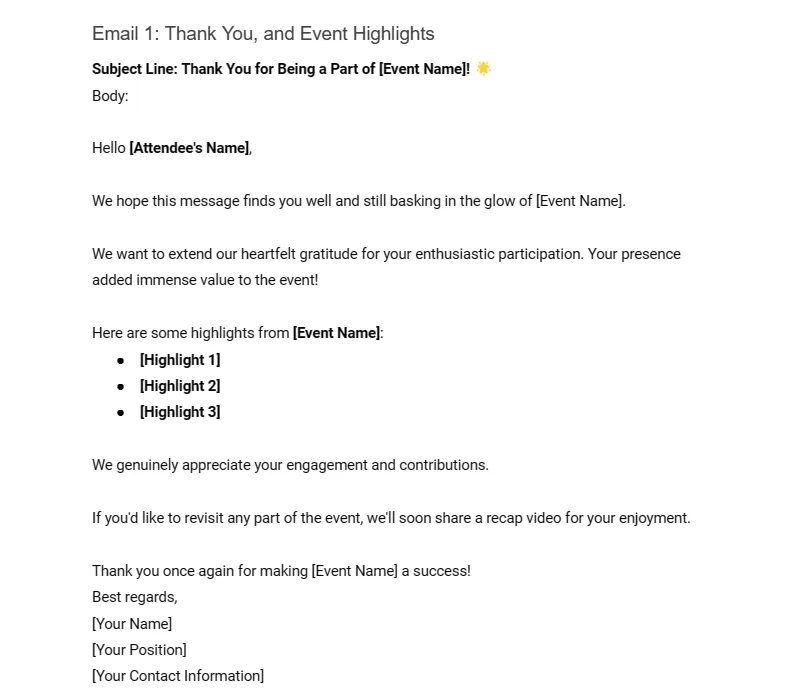


Soliciting Feedback After a Service or Purchase
Obtaining feedback from customers after they've experienced your service or made a purchase is crucial for improving your offerings and maintaining customer satisfaction. Crafting an email that encourages honest feedback while showing appreciation is key to building lasting relationships.



Following Up on Partnership and Collaboration Offers
After extending an invitation for a potential partnership or collaboration, it's essential to maintain communication and express continued interest. Crafting a courteous follow-up email that emphasizes mutual benefits and seeks further discussion can strengthen the foundation for a successful collaboration.
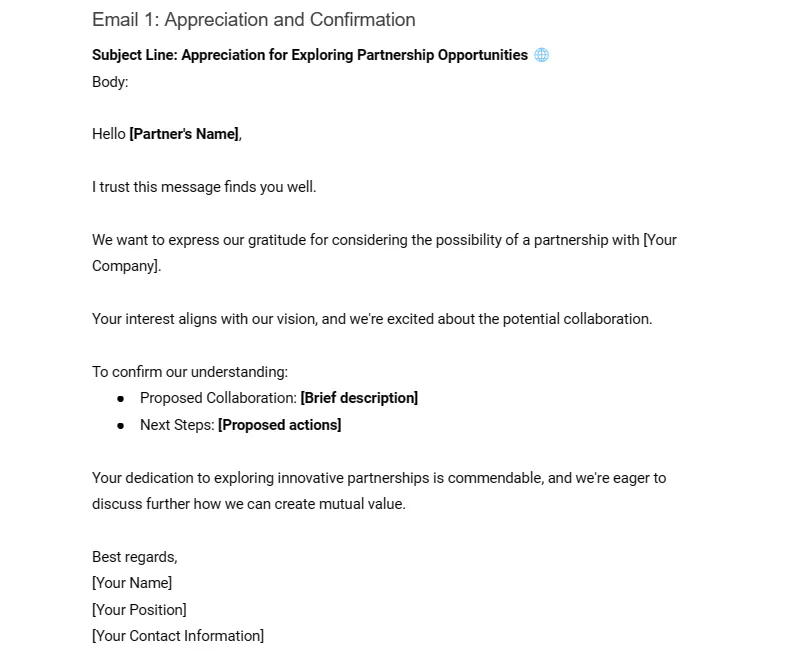


Reminding Clients About Subscription Renewals
As the subscription renewal period approaches, reminding clients about the upcoming deadline is crucial. Crafting a friendly yet informative reminder email helps ensure clients are aware of the expiration date, prompting them to renew their subscriptions promptly.

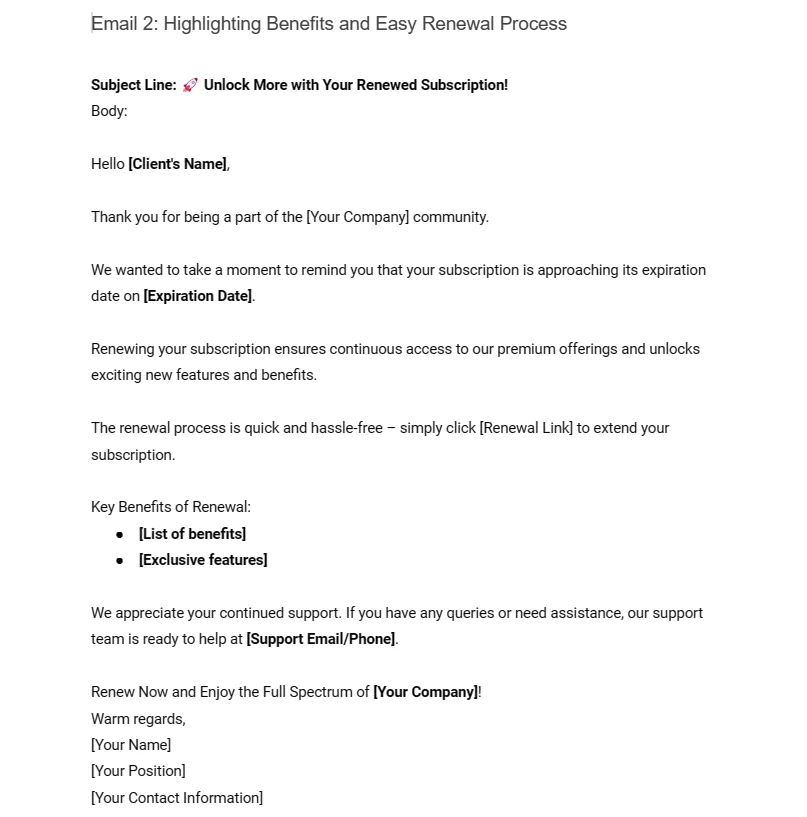
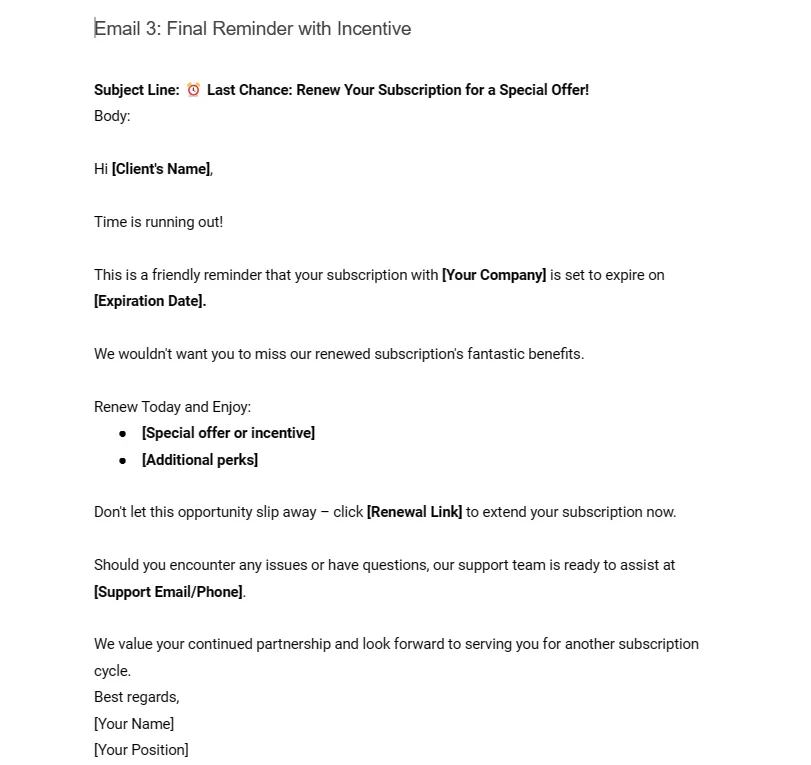
Maximizing Response Rates with Expert Techniques
How Many Follow-Ups Are Too Many?
Determining the optimal number of follow-up emails is vital.
While you want to maintain visibility, it's important to avoid becoming a source of annoyance. A general rule is to limit yourself to two or three follow-up emails.
This number strikes the right balance between demonstrating your persistence and respecting the recipient's inbox.
- Too Many Follow-Ups Can Backfire: Overdoing follow-ups might lead to diminishing returns and could even mark your emails as spam.
- Initial Follow-Up: Send your first follow-up email about a week after the initial contact. This shows your interest without being overbearing.
- Subsequent Follow-Ups: Two to three follow-ups, spaced out over a few weeks, are generally effective. This demonstrates persistence without appearing desperate.
- Final Touch: If there's still no response, a final courteous email expressing your availability for future correspondence can be sent.
Personalizing Each Email for Your Target Audience
Each email template and follow-up email sequence should be tailored to your recipient.
Personalization goes beyond just addressing them by name; it involves crafting content that resonates with their specific interests, pain points, or previous interactions through other channels.
This strategy demonstrates that you're not just sending a generic message but a thoughtfully designed one for them.
The Power of Personalized Greeting: A personalized approach can significantly increase the chances of getting a response, making each email feel like a part of a continuous, meaningful conversation.
Mention Past Interactions: Reference previous conversations or points of connection to reinforce the relationship.
Address Specific Needs: Tailor the content to address the recipient's unique challenges or interests.
Use a Personalized Greeting: Address the recipient by name and include a personal touch, such as commenting on a recent accomplishment.
Importance of Subject Lines
The subject line is the first thing your recipient sees and can make or break your email's chances of being opened.
Crafting a strong subject line is crucial - it should be clear, concise, and compelling. Consider using the original subject line for continuity or tweaking it to add freshness.
Effective Subject Lines: A well-crafted subject line can intrigue the recipient, prompt curiosity, and encourage them to read the email.
Avoiding Spam Filters and Ensuring Your Email Gets Read
Navigating spam filters is a key aspect of effective email communication.
Avoid using overly promotional language or too many links, as these can trigger spam filters. Ensure your emails provide immediate value, enhancing the chances of being read and responded to.
Keeping Emails Spam-Free: Understand the nuances of spam filters and craft your emails to ensure they land in the main inbox, not the spam folder.
Avoid Overuse of Sales Language: Steer clear of overly promotional phrases that are typical spam triggers.
Appropriate Use of Links: Limit the number of links in your email to avoid being flagged as spam.
Maintain a Professional Tone: A professional, conversational tone is less likely to be marked as spam than a casual or overly salesy tone.
Sharing Contact Info For Response
Including your contact information in each follow-up, email makes it easier for the recipient to reach out to you. This can be as simple as ensuring your email signature contains your phone number or a link to your LinkedIn profile.
Easy Accessibility: Providing clear contact info invites the recipient to engage with you on different channels, potentially increasing your response rate.
Clear Contact Details: Include your phone number and other contact information in your email signature.
Alternative Contact Methods: Offer options like scheduling a call or meeting via a linked calendar.
When to Send Follow-ups
Timing your follow-ups is as important as their content.
Consider the recipient’s time zone, typical working hours, and even days of the week.
For instance, sending an email early in the morning or in the middle of the workweek might increase its visibility.
Strategic Timing: Utilize data on email response rates to choose the best time for sending your follow-ups, enhancing their effectiveness.
Consider Work Hours: Sending emails during typical business hours increases the likelihood of them being seen.
Day of the Week Matters: Mid-week emails often have higher open rates compared to those sent on Mondays or Fridays.
Be Mindful of Time Zones: If your recipient is in a different time zone, consider sending the email at a time that works best for them.
Advanced Techniques in Follow-Up Emails
Writing Follow-Up Emails That Increases Conversion Rates
Effective follow-up emails are key to driving higher conversion rates. Here's how to optimize your follow-ups for maximum impact:
Understanding Your Target Audience: Tailor your content to address your audience's specific needs and pain points. This increases relevance and engagement.
Creating a Strong Call to Action: A clear, compelling call to action in your follow-ups can dramatically increase conversion rates. Whether it's a prompt to complete a purchase, sign up for a service, or attend an event, make sure your CTA stands out.
Utilizing Email Sequence for Consistency: Develop a structured email sequence where each follow-up builds upon the previous one. This continuity keeps the conversation flowing and leads the recipient towards the desired outcome.
Effective Strategy Analysis: Regularly analyze the response rate of your follow-up emails. Use these insights to refine your approach, ensuring you're meeting the expectations and interests of your potential clients.
Using the Same Subject Line for Continuity
Maintaining the same subject line in follow-up emails can be a strategic choice:
Thread Recognition: The same subject line helps recipients quickly recognize and associate your follow-up with the original email. This can be especially effective in scenarios like job applications or sales pitches.
Enhancing Email Visibility: A consistent subject line can make your email stand out in a crowded inbox, especially if the initial email has piqued the recipient's interest.
Building Relationships Through Polite Follow-Up Emails
The tone of your follow-up emails can significantly influence your relationship with the recipient:
Politeness and Respect: A polite follow-up email, possibly starting with a personalized greeting, shows respect for the recipient's time and consideration.
Personal Touch: Personalizing your email, perhaps by mentioning a pleasure speaking with them previously or referencing a shared experience, can foster a sense of connection.
Balanced Frequency: Understand the right balance in sending follow-ups. Avoid too many follow ups, which might be seen as intrusive, and aim for a frequency that keeps you in touch without overwhelming the recipient.
Providing Additional Context: Each follow-up should add value to the ongoing conversation. Briefly recap your previous email and include any new information or perspectives that might be helpful.
Expert Tips for Crafting the Perfect Follow-Up Email
How to Follow Up Without Being Annoying
Navigating the delicate art of sending follow-up emails without coming across as annoying is crucial. This involves understanding the right balance between persistence and respect for the recipient's time.
It's not just about sending a reminder but making each follow-up a meaningful touchpoint that nudges the recipient towards a desired outcome.
Timing and Frequency: Ideally, a week should pass before you send your first follow-up. Subsequent emails can follow, each spaced a week apart, showing persistence without being overbearing.
Content Value: Each email should contribute new insights or a gentle reminder, adding to the previous conversation rather than just repeating it.
Polite Persistence: Adopt a tone that is respectful yet confident. Phrases like "I understand you're busy, but I'd appreciate your feedback on..." can be effective.
Ensuring Your Email Adds Additional Context and Value
A follow-up email should always build upon the previous interaction or the original email. It's an opportunity to deepen the conversation, providing the recipient with new information or perspectives that make reopening your email worthwhile.
Contextual Clarity: Start with a reference to your initial email, setting the stage for your follow-up message.
Informative Updates: Share updates or information like a successful follow-up email example, relevant data, or industry news that could be of interest to your recipient.
Targeted Approach: Customize your content to address your target audience's specific needs, ensuring that your follow-up is relevant and engaging.
Encouraging Continuous Improvement in Follow-Up Email Templates
The art of writing successful follow-up emails involves continuously refining your follow-up email templates.
All the difference between high and low conversion rate lies here.
This process involves updating the content and ensuring that each template resonates with your recipients' evolving needs and preferences.
Template Testing: Regularly test various components of your email templates, like experimenting with different subject lines, to determine what elicits the best engagement.
Feedback Integration: Incorporate feedback or insights gathered from previous email interactions to improve your templates, making them more effective.
Evolution with Trends: Stay updated with the latest email marketing trends and adjust your templates to avoid issues like spam filters, ensuring your emails consistently reach your intended audience.





.jpg)

.jpg)
